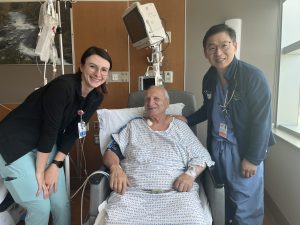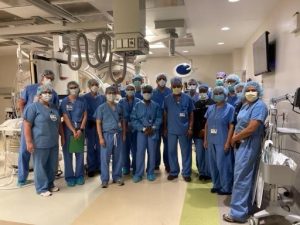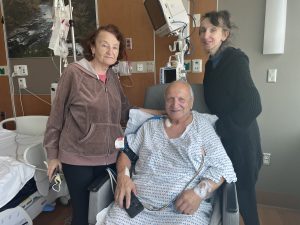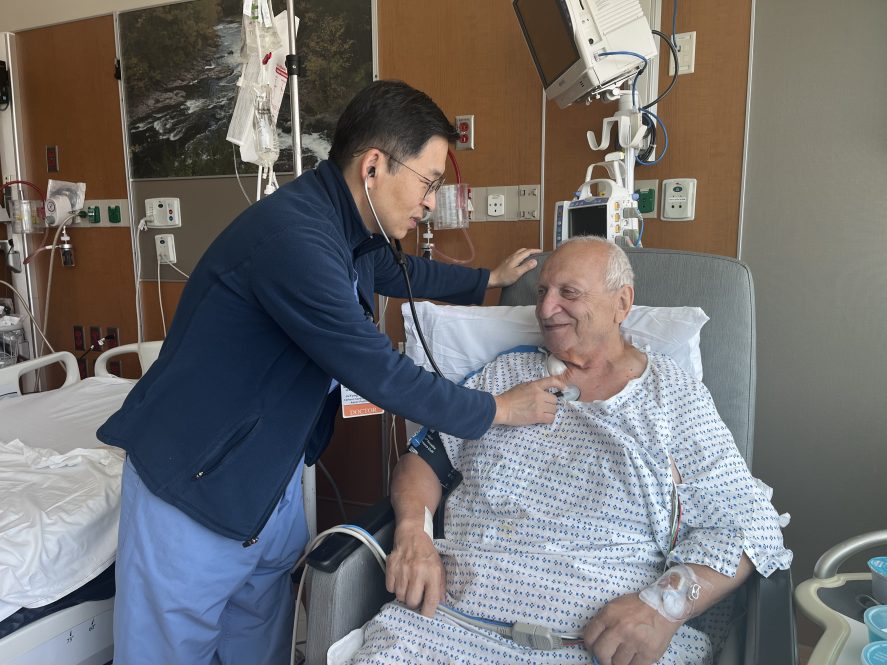Just twenty-four hours after a heart procedure Leonid Katsnelson, 72, of West Hartford was singing the praises of his UConn Health cardiovascular surgeons.
“I can’t believe it. I feel no pain,” says Katsnelson, who is no longer short of breath or fatigued from his aortic stenosis, the narrowing of his aortic heart valve. “I am very happy. I feel amazing. I thought I felt good, but now I feel the difference after the TAVR procedure.”
Katsnelson was discharged on the last day of September from UConn John Dempsey Hospital.
 He first came to the United States in 1993 with his wife Galina and two children. “I came to the US and Connecticut for more opportunities, and lots of my family were already here,” says the retired nursing home maintenance worker and part-time pizza deliveryman who loves to drive.
He first came to the United States in 1993 with his wife Galina and two children. “I came to the US and Connecticut for more opportunities, and lots of my family were already here,” says the retired nursing home maintenance worker and part-time pizza deliveryman who loves to drive.
But seven years ago on Sept. 22, 2015, he had a massive heart attack. Sadly, his sister had earlier died of a heart attack.
“I felt not so good and had shortness of breath when walking. I immediately knew it was my heart. I remember I took a glass of milk and it fell from my hand. I lost all strength. I felt an empty feeling and numbness,” he says.
His wife called 9-1-1 and the ambulance took him to UConn Health, where he first crossed paths with Pat and Jim Calhoun Cardiology Center’s Dr. JuYong Lee, who quickly restored blood flow to his heart with cardiac stents.
“He was given a zero percent chance to survive due to cardiogenic shock,” recalls his daughter Eleonora Laber. “But Dr. Lee saved his life seven years ago.”
“I am very lucky. Dr. Lee is not a doctor, he’s magic!” says Katsnelson.
But recently Katsnelson’s aortic valve was becoming narrowed, Lee noticed at a follow-up appointment. Lee recommended that he have a newly available procedure at UConn Health called TAVR (Transcatheter aortic valve replacement).

UConn Health’s new TAVR Program combines the surgical expertise of Dr. Chittoor B. Sai Sudhakar, chief of cardiothoracic surgery who has significant experience in the field of TAVR over the last 13 years, and Lee, who serves as a lead of the structural heart program, director of vascular medicine, endovascular medicine, and the non-invasive vascular laboratory.
The program also includes a dedicated coordinator (Kristen Bryant), experienced Cath Lab staff (Patricia Fagan and others), APRNs (Wendi Carrol and Tao Wang) as well as an echocardiographer (Dr. Supriya Tigadi), cardiac anesthesiologists (Dr. Jason Altman, Dr. Rabi Panigrahi and others), interventional cardiologists (Dr. Michael Azrin and Dr. Wael El Mallah), and radiologists (Drs. Clifford Yang, Electra Kaloudis and Jonathan Hargreaves).
“My father wouldn’t be alive if it wasn’t for Dr. Lee and also Dr. Sai and their UConn Health teams,” says Katsnelson’s daughter.

Wife Galina and daughter Eleonora are both overjoyed with the successful TAVR procedure’s immediate outcome.
“My Dad can talk, walk, and he’s going home with us! He has a lot to look forward to,” Eleonora says. “He now is filled with so much joy!”
Katsnelson wants the world to know all about UConn Health, its excellent care, and the fellow joy of its health care workforce.
“I love UConn Health. The people here have helped me so much. Everybody is happy here and smiling – every single person from the moment of walking into the hospital to the moment of discharge,” he says.
Narrowing of the aortic valve can occurs as we age when calcium builds up around the valve’s opening restricting proper blood flow to the rest of the body. The common older adult heart condition affects more than 20% of those over the age of 65.
The aortic stenosis warning signs, which if left untreated can lead to heart failure or even death, may include:
- Fatigue
- Shortness of breath
- Chest pain
- Rapid fluttering heartbeat
- Trouble walking short distances
- Reduced routine activity level
- Fainting and lightheadedness
“It is critical for older adults, along with their primary care physicians and cardiologists, to be aware of the early warning signs of aortic stenosis to ensure a rapid diagnosis of the condition so a lifesaving minimally invasive intervention such as TAVR can be offered,” says Sai, chief of cardiothoracic surgery at UConn Health.
“Aortic valve stenosis is very easy to detect by echocardiography which is a heart ultrasound when physicians can listen for murmur in the chest,” says Lee.
“TAVR gives a lot of older patients, who may not be good candidates for open heart surgery, the opportunity to get relief from their symptoms and get back to enjoying their lives rather quickly. It’s quite remarkable to see the impact it has on patients and their families,” says Bryant, Structural Heart Program Coordinator.



